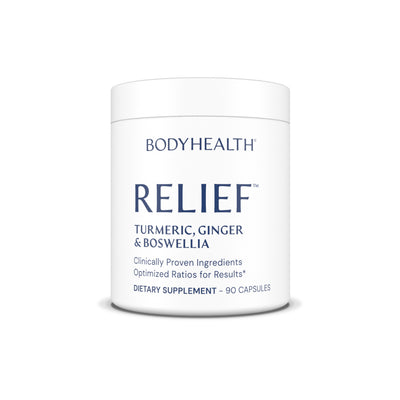90% Of Body Fat Is Made From Sugar — Not Fat
September 04, 2025 7 min read

This article is part of the Guide To Sustainable Fat Loss, a series that includes articles on key topics and a precise protocol to help you lose inches and keep them off, reduce cravings, shape and tone body and muscle, address hunger and fat loss hormones, improve sleep and mood, and much more.
You can find a complete index to this series at the bottom of this article.
Where Body Fat Actually Comes From
Did you know about 90% of what most of us consider to be body fat is actually made by and from sugar.
Just not how you think.
And it has a lot more to do with how it affects your hormones (messenger chemicals that tell your body how to use the food you put into it).
Because it’s your hormones that will determine what will ultimately happen with this sugar and whether or not it will be used to make new body fat.
First, let’s break down what actually happens when we consume carbs and what hormones come into play here.
Now, when we think of “gaining fat” or “being overweight” we’re not talking about the fat that makes up 50% of each of our cells and must be there for our survival. (The outside membrane of each of our cells is made of different fatty acids. Without these we’d have no cells.)
No, we’re talking about the fat under our skin and stored in our fat cells, which exist only as fat storage centers. This is about 90%-95% of what we think of as our “body fat."
But this fat isn’t just made of fat. It's a very specific type of fat (there are many) made of part sugar and part fatty acid and looks a bit like a tadpole with a sugar head and three tails made from chains of fatty acids.
This three-tailed tadpole of a fat is called a Triglyceride.
Glyceride refers to the sugar head and “Tri-” is for the three fatty acid tails.
These Triglycerides are the fats stored in your fat cells and what you’re trying to keep off your body if you want to be lean.
Note: They can also be stuck to the walls of your blood vessels causing high blood pressure, heart disease, or shoved in between cells in your organs, causing various organ troubles. But that’s another article).
But no matter where they are, triglycerides require both the sugar head and the three fatty acid tails. If you only had sugars or only had fatty acid chains, you wouldn’t get one of these triglycerides and it couldn’t be stored in your fat cells.
So how are these formed?
When we eat carbohydrates (bread, fruit, grains, beans, candy, etc) it’s all one thing to the body — sugar.
Some sugars may be broken down slower and some faster, but they all end up as something called glucose — blood sugar.
Now, when sugar hits the blood stream it needs to be cleared out for two main reasons: first, so it can be used as energy, and second, because higher levels of sugar are harmful to the walls of our blood vessels and can cause injury to them.
So when sugar comes in our body releases a hormone (a messenger chemical that instructs the cells on what to do) called Insulin. Insulin’s job is to clear the sugar out of the blood stream.
And Insulin does this in one of three main ways and in this basic order:
First, it tells the cells throughout your body to take in the sugar so it can be mixed with oxygen to create something called ATP (the actual energy form the cells use).
Second, if the cells are full, then Insulin tells the muscle and liver to take in the extra sugar and turn it into chains of sugar to be stored for fast use in the future. These chains of sugar are called glycogen or glycogen stores.
And third, if there is still too much sugar for the above, because both the cells and the glycogen stores are full, then insulin directs the body to connect up the sugar with fatty acid chains and convert it all into triglycerides — body fat, which is then stored in your fat cells.
Now, this fat is a sort of energy savings account.
You see, later on, if the cells are out of glucose (sugar), and there is no more sugar in the blood to put into the cells, then the body releases a different hormone called Glucagon.
Glucagon goes to the muscles and liver and breaks the glycogen (stored chains of sugar) back into individual sugars for use.
This then causes the release of Insulin again which lets this newly released sugar into the cells.
Then later, if these cells are again empty, and all the glycogen stores are depleted, the Glucagon is release again and tells the body to release an enzyme called Lipase. (Enzymes are chemicals in the body that cause chemical reactions.)
Now the Lipase goes to the fat cells (energy savings account) and starts breaking down the triglycerides (body fat).
It does this by releasing the sugar head (glucose), but also by converting the fatty acid chains into something called ketones. It’s a bit more complicated than that, but ketones are basically another energy source the cells can use in place of glucose.
Now, while all of this is happening all of the time to some degree, it all happens mainly in that basic order.
So from a practical view we see that if we consume more carbs than our bodies can put into the cells or store as glycogen, then we build fat. And if we have extra fat we want to get rid of, we need consume less carbs than our body needs to operate so that it’s willing to tap into the fat stores for energy instead.
But even more key, while insulin is in your blood stream (which it will be until the sugar is cleared out), the hormone glucagon, and the fat-burning enzyme lipase, are suppressed, and fat burning is very minimal. Obviously, because why use your savings account (body fat) when you’ve got new energy coming in already?
But this also means that if we’re constantly eating high sugar foods throughout the day, then we have higher insulin levels in our blood stream throughout the day and no amount of exercise will get rid of our fat because… the hormone Glucagon and the enzyme Lipase are suppressed, so fat burning can’t occur.
It also means that even if we cut calories, if the main calories we leave in are carbohydrates… we won't be losing body fat, or very little.
This is because the Glucagon and Lipase will be suppressed, but also because of another hormone, Cortisol, we’ll cover later. This hormone, when sugars are high constantly, acts to break down muscle for energy and to conserve body fat. But we’ll cover that more later.
This is why people do intermittent fasting or fasted workouts. They eat dinner at around 6pm and then don’t eat breakfast the next morning. At this point the sugar has been out of the blood stream for many hours and, if a workout is done, the body will quickly go through its glycogen stores and then tap into the fat stores.
Then, if the person doesn’t eat again until lunch time you have several hours where glucagon and lipase are active to break down fat for energy.
So to recap: While sugar is in the blood stream we have the potential of fat creation and the prevention of fat-burning. And when sugar is out of the blood stream for many hours we have the potential of fat being utilized for energy, and so, fat loss.
But there’s more to it than this.
Why can't some people lose fat even if they cut out sugars?
What kind of sugar does this?
How long will it take before fat burning starts for me, hours, days weeks?
And what about Insulin resistance and Cortisol?
Don't worry, we get into all that in the next articles.
Until then, message us in the Facebook Group if you have any questions or need anything. And you can also share your progress there and see others' progress.
You can save at least 15% when purchasing a 30-Day Fat Loss Challenge Package for this protocol, or continued savings of 15% with a subscription.
And if you haven't seen the Guide To Sustainable Fat Loss & 30-Day Challenge, check them out.
On this protocol we lose inches, reduce cravings, and address hormones, sleep, and much, much more.
You'll love it.
Index To The Guide To Sustainable Fat Loss:
Introduction & Getting Started:
- Introduction To Sustainable Fat Loss & The 30-Day Challenge
- The Key To Sustainable Fat Loss: Calories + Hormones
- The 30-Day Fat Loss Challenge: Diet & Protocol
- The 30-Day Fat Loss Challenge: Workout
- Workout Videos To Ensure Proper Form
Week One:
- What Makes Fat Loss So Hard
- Succeeding At Your Diet: Cravings, Hormones & What To Watch For
- 90% Of Body Fat Is Made From Sugar — Not Fat
- Reversing Insulin Resistance & Speeding Fat Loss
Week Two:
- Hunger Hormones: What's Causing Cravings For Sugar & Junk Food
- Digestion Is Key To Sustainable Fat Loss
- Cortisol: The Hormone That Makes Fat Loss Nearly Impossible
Week Three:
- How Poor Sleep Prevents Fat Loss
- Estrogen Dominance Prevents Fat Loss In Women & Men
- Raising Growth Hormone & IGF For Fat Loss
Week Four:
- Hunger Vs Cravings: When To Transition Out Of Fat Loss
- Transitioning From Fat Loss To Lean Body
- How Our Corn & Soy Based Diet Prevents Fat Loss
Week Five:
Articles by Health Topic
Your Path To Better Health Starts Here!
From in-depth articles on nutritional benefits to updates on new product launches, stay informed and inspired on your journey to optimal health.
*These statements have not been evaluated by the Food and Drug Administration. These products are not intended to diagnose, treat, cure, or prevent any disease.










